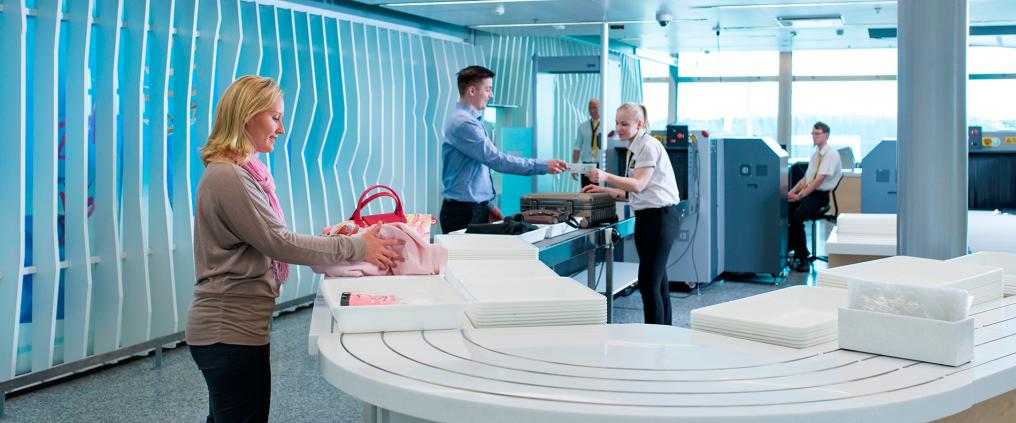Airport security screening history began rather simply: Ticket agents and security personnel inspected each traveler, looking for behavior that potential hijackers might exhibit, such as lack of eye contact or inadequate concern about their luggage. Over the years, it evolved as a way to control the trafficking of contraband before it ultimately became the frontline of counter-terrorism and border control.
At Helsinki Airport, the use of walk-through metal detectors (WTMD) started in 1972.
“The WTMD was used to screen passengers flying to the US due to the number of aircraft hijackings in the States. One of the main players in this field was the Finnish stainless steel company Outokumpu,” says Kari Nurmela, System Specialist of Finavia.
In 1975, the National Board of Aviation purchased Finland’s first X-ray machine. The piece of equipment was used during the Conference on Security and Cooperation in Europe (CSCE), held in Helsinki.
“We used it to screen the bags of members of the press and the machine was located in Hakasalmi Villa, beside Finlandia Hall near Töölönlahti bay,” he recalls.
“During the CSCE, the police used their own X-ray equipment to check items at the airport, but that wasn’t similar to ours as theirs didn’t have a conveyor belt. After the summit, we began to use the machine to screen passengers at Helsinki Airport,” Nurmela clarifies.
Increased levels of safety
Terror-related events have created pressure on the aviation industry to raise its safety level.
“After the Lockerbie incident in 1988, hold baggage screening (HBS) was introduced and Helsinki Airport received its first piece of X-ray equipment in 1989,” he continues.
Nurmela states that 100% or compulsory HBS only began at the beginning of 2003 due to the events of September 11, 2001.
“In 2002, we were busy furnishing all our airports with X-ray equipment to screen hold baggage.”
According to Auli Kankkunen, Senior Inspector, Aerodromes and Aviation Security Unit, Finnish Transport Safety Agency Trafi, in the 2000s following the September 11 attacks, the screening of staff and crew members began.
“Restrictions on the carriage of liquids in cabin baggage were implemented in 2006. In the beginning, it was a liquid ban. Later came the screening of liquids using special equipment. In addition, Explosive Trace Detection is now used in passenger and cabin baggage screening,” she says.
She explains that these measures were introduced via European Union security legislation after various attempts to bring improvised explosive devices into aircraft in other parts of the world.
The role of technology and legislation
Emerging technologies, coupled with laws and regulations, also play a role in the evolution of airport security measures.
“X-ray machines have improved a lot since 1975 and are today equipped with, for instance, explosive detection system capabilities. X-ray machines are usually upgraded when better software with better detection capabilities become available,” says Kankkunen.
“As a member state of the European Union, Finland and airports in Finland implement EU legislation. Security equipment is upgraded in accordance with its requirements.”
Nurmela says that while X-ray machines are now able to recognize bulk and liquid explosives, or offer several views from different angles or in 3D, today the industry is exploring solutions such as remote screening.
“This means that the security officers analyzing X-ray images are located somewhere other than next to the equipment itself. With hold luggage, this has been done on-site since the 1990s. The use with carry-on or hand luggage only started in an actual environment four to five years ago.”
Nurmela says that Finavia has tested remote screening and will begin to use it in the Plaza screening area of the new terminal extension in 2019.
“At the same time, we are considering remote screening not only on-site, but also, for example, with having an operator at another airport doing the screening.”
Tomorrow’s scanners
In addition, the use of body scanners – officially called security scanners (SSc) by the European Commission’s CBRNE (Chemical, Biological, Radiological, Nuclear, and Explosives) Glossary – has also been introduced at some of the world’s airports.
“The first tests in Europe were done during the 1990s. Finavia conducted its first test from 2007 to 2008 and the most recent one from 2016 to 2017,” notes Nurmela.
This technology, like others before it, has had its teething problems, but with SSc there have been privacy issues as well as radiation concerns.
“Today X-rays are not allowed to be used to screen passengers in the EU. The technology used instead is based on mmWaves, or millimeter waves, which occupy the frequency spectrum from 30 GHz to 300 GHz. Finavia is looking to use SScs as an option in the Plaza screening area, and the final decision will be made next summer.”



